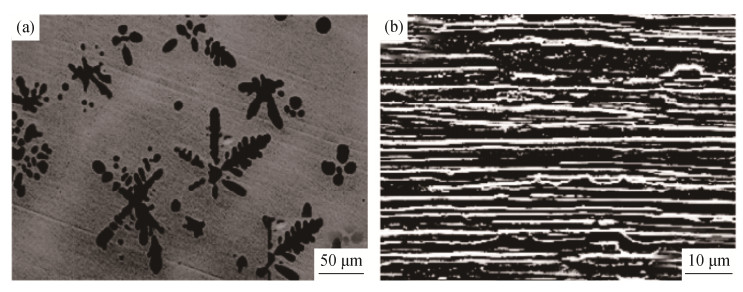| [1] |
Liu R R, Zhou H T, Zhou X, et al. Present situation and future prospect of high-strength and high-conductivity Cu alloy. Mater Rev, 2012, 26(19): 100 doi: 10.3969/j.issn.1005-023X.2012.19.023刘瑞蕊, 周海涛, 周啸, 等. 高强高导铜合金的研究现状及发展趋势. 材料导报, 2012, 26(19): 100 doi: 10.3969/j.issn.1005-023X.2012.19.023
|
| [2] |
Qiu P F, Shi X, Chen L D. Cu-based thermoelectric materials. Energy Storage Mater, 2016, 3: 85 doi: 10.1016/j.ensm.2016.01.009
|
| [3] |
Habibi A, Ketabchi M, Eskandarzadeh M. Nano-grained pure copper with high-strength and high-conductivity produced by equal channel angular rolling process. J Mater Process Technol, 2011, 211(6): 1085 doi: 10.1016/j.jmatprotec.2011.01.009
|
| [4] |
Martínez C, Briones F, Rojas P, et al. Microstructural and mechanical characterization of copper, nickel, and Cu-based alloys obtained by mechanical alloying and hot pressing. Mater Lett, 2017, 209(15): 509 http://www.sciencedirect.com/science/article/pii/S0167577X1731282X
|
| [5] |
Li Y Y, Ni K Y, Zhu F W. Study of TiC particle-reinforced Cu matrix composites. Powder Metall Technol, 2018, 36(2): 106 doi: 10.19591/j.cnki.cn11-1974/tf.2018.02.005李月英, 倪慨宇, 祝夫文. TiC颗粒增强铜基复合材料的研究. 粉末冶金技术, 2018, 36(2): 106 doi: 10.19591/j.cnki.cn11-1974/tf.2018.02.005
|
| [6] |
Eze A A, Jamiru T, Sadiku E R, et al. Effect of titanium addition on the microstructure, electrical conductivity and mechanical properties of copper by using SPS for the preparation of Cu‒Ti alloys. J Alloys Compd, 2018, 736(5): 163 https://www.sciencedirect.com/science/article/abs/pii/S0925838817338860
|
| [7] |
Zhou Y J, Song K X, Mi X J, et al. Phase transformation kinetics of Cu‒Be‒Co‒Zr alloy during aging treatment. Rare Met Mater Eng, 2018, 47(4): 1096 doi: 10.1016/S1875-5372(18)30126-7
|
| [8] |
Uporov S, Bykov V, Estemirova S. Electrical and thermal conductivities of rapidly crystallized Cu‒Zr alloys: The effect of anharmonicity. Physica B, 2016, 499: 97 doi: 10.1016/j.physb.2016.07.010
|
| [9] |
Guryev V V, Polikarpova M V, Lukyanov P A, et al. Size effects influence on conducting properties of Cu‒Nb alloy microcomposites at cryogenic temperature. Cryogenics, 2018, 90: 56 doi: 10.1016/j.cryogenics.2018.01.010
|
| [10] |
Shen Y, Xie M, Bi J, et al. Effects of different preparation techniques on mechanical property and electrical conductivity of Cu-8wt% Ag alloy by continuous casting. Rare Met Mater Eng, 2016, 45(8): 1997 doi: 10.1016/S1875-5372(16)30161-8
|
| [11] |
Darling K A, Huskins E L, Schuster B E, et al. Mechanical properties of a high strength Cu‒Ta composite at elevated temperature. Mater Sci Eng A, 2015, 638(25): 322 http://www.sciencedirect.com/science/article/pii/S0921509315004761
|
| [12] |
Zhao Q, Shao Z B, Leng Q C, et al. Preparation of Cu‒Cr alloy powder by heat mechanical alloying and Box-Behnken design based optimization. Powder Technol, 2017, 321: 326 doi: 10.1016/j.powtec.2017.08.039
|
| [13] |
Shi G D, Chen X H, Jiang H, et al. Strengthening mechanisms of Fe nanoparticles for single crystal Cu-Fe alloy. Mater Sci Eng A, 2015, 636: 43 doi: 10.1016/j.msea.2015.03.081
|
| [14] |
Shi G D, Chen X H, Jiang H, et al. Dendrite remelting of petal-shaped iron-rich nanoparticles in Cu-2wt% Fe alloy at the nanoscale. Mater Lett, 2016, 166: 231 doi: 10.1016/j.matlet.2015.12.096
|
| [15] |
Ma T, Li Y G. Research progress on Cu‒Fe alloys. Foundry Technol, 2016, 37(7): 1311 https://www.cnki.com.cn/Article/CJFDTOTAL-ZZJS201607001.htm马涛, 李运刚. Cu‒Fe合金的研究现状. 铸造技术, 2016, 37(7): 1311 https://www.cnki.com.cn/Article/CJFDTOTAL-ZZJS201607001.htm
|
| [16] |
Abbas S F, Park K T, Kim T S. Effect of composition and powder size on magnetic properties of rapidly solidified copper‒iron alloys. J Alloys Compd, 2018, 741(15): 1188 http://www.sciencedirect.com/science/article/pii/S0925838818302524
|
| [17] |
Bevk J, Harbison J P, Bell J L. Anomalous increase in strength of in situformed Cu‒Nb multifilamentary composite. J Appl Phys, 1978, 49(12): 6031 doi: 10.1063/1.324573
|
| [18] |
Bi L M, Liu P, Chen X H, et al. Effect of deformation ways on microstructure and properties of deformation-processed Cu‒8.3Fe‒1Ag in-situ composites. Trans Mater Heat Treat, 2012, 33(3): 28 https://www.cnki.com.cn/Article/CJFDTOTAL-JSCL201203005.htm毕莉明, 刘平, 陈小红, 等. 变形方式对Cu‒8.3Fe‒1Ag形变原位复合材料组织性能的影响. 材料热处理学报, 2012, 33(3): 28 https://www.cnki.com.cn/Article/CJFDTOTAL-JSCL201203005.htm
|
| [19] |
Zou J, Wan Z Z, Liu F Y. Research and prospect on Cu‒Fe deformation processed in-situ composites. Heat Treat Technol Equip, 2017, 38(5): 11 https://www.cnki.com.cn/Article/CJFDTOTAL-GWRC201705003.htm邹晋, 万珍珍, 刘方宇. Cu‒Fe形变原位复合材料的研究和发展. 热处理技术与装备, 2017, 38(5): 11 https://www.cnki.com.cn/Article/CJFDTOTAL-GWRC201705003.htm
|
| [20] |
Wen S F. Study on Deformation Cu‒14Fe in situ Composite[Dissertation]. Changsha: Central South University, 2011温盛发. 形变Cu‒14Fe原位复合材料研究[学位论文]. 长沙: 中南大学, 2011
|
| [21] |
Zuo X W, Qu L, Zhao C C, et al. Nucleation and growth of γ-Fe precipitate in Cu‒2% Fe alloy aged under high magnetic field. J Alloys Compd, 2016, 662: 355 doi: 10.1016/j.jallcom.2015.12.046
|
| [22] |
Liu K M, Lu D P, Zhou H T, et al. Influence of a high magnetic field on the microstructure and properties of a Cu‒Fe‒Agin situcomposite. Mater Sci Eng A, 2013, 584(6): 114 http://www.sciencedirect.com/science/article/pii/S0921509313007740
|
| [23] |
Liu S C, Jie J C, Dong B W, et al. Novel insight into evolution mechanism of second liquid-liquid phase separation in metastable immiscible Cu‒Fe alloy. Mater Des, 2018, 156: 71 doi: 10.1016/j.matdes.2018.06.044
|
| [24] |
Sarkar S, Srivastava C, Chattopadhyay K. Development of a new class of high strength copper alloy using immiscibility route in Cu‒Fe‒Si system: Evolution of hierarchical multi-scale microstructure. Mater Sci Eng A, 2018, 723: 38 doi: 10.1016/j.msea.2018.03.026
|
| [25] |
Guo M X, Wang F, Yi L. The microstructure controlling and deformation behaviors of Cu‒Fe‒C alloy prepared by rapid solidification. Mater Sci Eng A, 2016, 657: 197 doi: 10.1016/j.msea.2016.01.068
|
| [26] |
Jo H R, Kim J T, Hong S H, et al. Effect of silicon on microstructure and mechanical properties of Cu‒Fe alloys. J Alloys Compd, 2017, 707: 184 doi: 10.1016/j.jallcom.2016.12.352
|
| [27] |
He T Q, Wang L, Peng C X, et al. Liquid phase separation of Fe‒Cu alloy. J Mater Eng, 2016, 44(2): 115 https://www.cnki.com.cn/Article/CJFDTOTAL-CLGC201602019.htm何统求, 王丽, 彭传校, 等. Fe‒Cu合金相分离过程. 材料工程, 2016, 44(2): 115 https://www.cnki.com.cn/Article/CJFDTOTAL-CLGC201602019.htm
|
| [28] |
Liu S C, Jie J C, Guo Z K, et al. Solidification microstructure evolution and its corresponding mechanism of metastable immiscible Cu80Fe20 alloy with different cooling conditions. J Alloys Compd, 2018, 742(25): 99 http://smartsearch.nstl.gov.cn/paper_detail.html?id=ef99626f49052fdcb0d037c61de81c16
|
| [29] |
Xie Z X, Gao H Y, Lu Q, et al. Effect of Ag addition on the as-cast microstructure of Cu-8wt% Fe in situ composites. J Alloys Compd, 2010, 508(2): 320 doi: 10.1016/j.jallcom.2010.08.063
|
| [30] |
Liu K M, Lu D P, Zhou H T, et al. Effect of Ag micro-alloying on the microstructure and properties of Cu-14Fe in situcomposite. Mater Sci Eng A, 2010, 527(18-19): 4953 doi: 10.1016/j.msea.2010.04.051
|
| [31] |
Gao H Y, Wang J, Shu D, et al. Microstructure and properties of Cu‒11Fe‒6Ag in situ composite after thermo-mechanical treatments. J Alloys Compd, 2007, 438(1-2): 268 doi: 10.1016/j.jallcom.2006.08.027
|
| [32] |
Li H X, Wang G Q, Jia S G, et al. Effects of silver on microstructure and properties of Cu‒10Fe‒0.15Zr in-situ composites. Heat Treat Met, 2011, 36(8): 9 https://www.cnki.com.cn/Article/CJFDTOTAL-JSRC201108003.htm李红霞, 王国强, 贾淑果, 等. Ag对Cu‒10Fe‒0.15Zr原位复合材料微观结构及性能的影响. 金属热处理, 2011, 36(8): 9 https://www.cnki.com.cn/Article/CJFDTOTAL-JSRC201108003.htm
|
| [33] |
Lu D P, Wang J, Zeng W J, et al. Study on high-strength and high-conductivity Cu‒Fe‒P alloys. Mater Sci Eng A, 2006, 421(1): 254 http://www.sciencedirect.com/science/article/pii/S0921509306001663
|
| [34] |
Meng Y Q, Sun S Q, Mao L, et al. Structure and properties of Cu‒Fe‒Cr‒Ni in-situ composites. J Hebei Univ Sci Technol, 2006, 27(4): 297 doi: 10.3969/j.issn.1008-1542.2006.04.009孟永强, 孙世清, 毛磊, 等. Cu‒Fe‒Cr‒Ni原位复合材料的结构与性能. 河北科技大学学报, 2006, 27(4): 297 doi: 10.3969/j.issn.1008-1542.2006.04.009
|
| [35] |
Benjamin J S. Dispersion strengthened superalloys by mechanical alloying. Metall Trans, 1970, 1(10): 2943 doi: 10.1007/BF03037835
|
| [36] |
Wang F L, Wakoh K, Li Y P, et al. Study of microstructure evolution and properties of Cu‒Fe microcomposites produced by a pre-alloyed powder method. Mater Des, 2017, 126(15): 64 https://www.sciencedirect.com/science/article/pii/S0264127517303738
|
| [37] |
Rabiee M, Mirzadeh H, Ataie A. Processing of Cu‒Fe and Cu‒Fe‒SiC nanocomposites by mechanical alloying. Adv Powder Technol, 2017, 28(8): 1882 doi: 10.1016/j.apt.2017.04.023
|
| [38] |
Yin S H, Dong Z Q, Fu J W, et al. Effect on mechanical alloying on structure and properties of microwave sintered alloy Cu20Fe80. Bearing, 2017(12): 21 https://www.cnki.com.cn/Article/CJFDTOTAL-CUCW201712007.htm尹素花, 董中奇, 付俊薇, 等. 机械合金化对微波烧结Cu20Fe80合金组织性能的影响. 轴承, 2017(12): 21 https://www.cnki.com.cn/Article/CJFDTOTAL-CUCW201712007.htm
|
| [39] |
He Z W, Wang M Z. Effect of mechanical alloying on sintering characteristics of Fe‒Cu compound powder. Powder Metall Ind, 2007, 17(4): 5 doi: 10.3969/j.issn.1006-6543.2007.04.002贺战文, 王明智. 机械合金化对Fe‒Cu粉末烧结性能的影响. 粉末冶金工业, 2007, 17(4): 5 doi: 10.3969/j.issn.1006-6543.2007.04.002
|
| [40] |
Jerman G A, Anderson I E, Verhoeven J D. Strength and electrical conductivity of deformation-processed Cu-15 Vol Pct Fe alloys produced by powder metallurgy techniques. Metall Trans A, 1993, 24(1): 35 doi: 10.1007/BF02669600
|




 下载:
下载:




